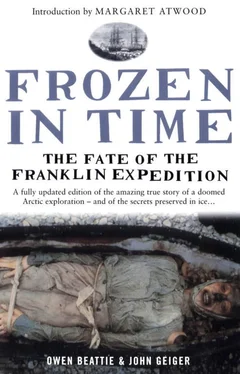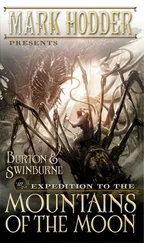There was another death on 8 July.
Before the ships departed from Port Leopold, Ross ordered that a depot be established. In it, he left behind a steam launch (with fuel), a shelter with carpenter’s tools, blankets, sleeping bags, stoves, provisions and other essential supplies, and an account of the expedition and its future plans. Gilpin: “Here then should any of Sir John Franklin’s people reach, they would find the means of subsistence and escape.”
After departing Port Leopold, Ross attempted to travel west, but the ships were beset on 1 September and carried by ice towards Baffin Bay. After three weeks they were freed, but with the intensifying malevolence of the disease amongst his men, Ross was forced to cut his losses, abandon his search and make a run for home. The Investigator’s cook died on 16 September during the homeward passage; the last case appeared less than a week before the ships limped into the English port of Scarborough in November 1849. Some of the sailors remained ill enough to require hospitalization, and one died shortly afterwards.
On 17 November, the Illustrated London News announced the expedition’s disappointing results, reporting the “great difficulty” encountered by the sledge parties and noting the deaths: “The assistant-surgeon, a very intelligent young man, and three able seamen of the Enterprise, with three of the crew of the Investigator, have died since the vessel left Woolwich in the spring of 1848.” The Athenaeum declared the search for Franklin “very incomplete”:
…the public mind can arrive at no conclusion for its anxiety from what has been done. But the issue of such examination as Sir James Ross has been enabled to institute makes a painful addition to the melancholy suggestions arising out of the long and deathlike silence which has fallen over the former Expedition.
Ross’s own health was broken. While many critics felt he should have braved a second winter, lamenting his “puny efforts,” John Robertson, the surgeon on the Enterprise, thought most of the men would not have survived another year:
There were few men in the ship who were not more or less afflicted by scurvy, and I cannot help fearing that had we remained out an other winter, few if any would have ever returned—this the more certain since our antiscorbutics proved such perfect failures.
One officer on the expedition wrote: “We have certainly had to grapple with difficulties of no ordinary nature.” Years later, M’Clintock reflected that “we underwent as much privation and fatigue as in any equal period of my subsequent travel.” Yet the truth was that Ross’s expedition was the only one with at least a theoretical chance of saving some of Franklin’s men. When his ships reached Port Leopold, some of the men may still have been alive; with Ross’s defeat, any chance of their being saved was lost.
Struggling to understand the severity of the sickness suffered aboard Ross’s ships, some historians have theorized that the problem might have been compounded by the crews being accepted for the expedition without medical examinations. Ross’s own officers complained that the ships’ canned provisions were not only underweight but of inferior quality, in Robertson’s words, “a disgrace to the contractor.” The same contractor—Stephan Goldner—had supplied Franklin’s expedition. Doubts about the antiscorbutic value of the lime juice carried on-ship were also raised, with subsequent chemical analysis concluding that there was no guarantee of “the initial soundness of the fruit.” This grave conclusion unfastened an exhaustive inquiry by Sir William Burnett, the navy’s medical director-general. All juice then in the victualling stores was analyzed, with the conclusion that it was all below the proper standard of acidity. It was, of course, a mistake to suppose that acidity was the vital element.
In the end, the Admiralty attributed the health problems that beset the expedition, and the unusual number of deaths, to scurvy. Ross, who had seen scurvy’s effects on some of his earlier expeditions, was unconvinced. He pointedly did not use the word “scurvy” in his official report of the expedition nor, indeed, did his men when later examined, saying that there had been “debility but no scurvy.” The ferocity of the illness was unequalled in nineteenth-century Arctic exploration. Not even Franklin’s expedition during its first year came close to experiencing the crippling losses encountered by James Clark Ross’s during its lone Arctic winter; at one point, twenty-six men were on the sick list. The mortality on Ross’s expedition was more than twice that of Franklin’s 1845–46 winter losses.
On 4 april 1850, the Toronto Globe published an advertisement announcing a £20,000 reward to be given by “Her Majesty’s Government to any party or parties, of any country, who shall render efficient assistance to the crews of the discovery ships under the command of Sir John Franklin.” A further £10,000 was offered to anyone able to relieve any of the crews or bring information leading to their relief. Finally, another £10,000 was offered to anyone succeeding in ascertaining the fate of the expedition.
By the autumn of 1850, a fleet of ships was combing the Arctic’s waterways for a sign of the missing explorers. The British Admiralty alone sent three expeditions consisting of a total of eight ships into the Arctic. One of the search expeditions, made up of the HMS Enterprise and HMS Investigator under the command of Captain Richard Collinson and Commander Robert McClure, was sent through the Bering Strait; Captain Horatio Thomas Austin, with second-in-command Captain Erasmus Ommanney, was ordered to take four ships into Lancaster Sound, while the third expedition, led by Arctic whaling master Captain William Penny, was sent north into Jones Sound.
As early as February 1849, Jane, Lady Franklin travelled to Hull, a port from which whalers sailed to Baffin Bay, “with a view to plead her anxieties and distresses and to animate the commanders to her cause.” She was among those active in the race to save her husband and his men, and with the help of supporters sent a ship to join in the search. As well, the United States Navy Department assisted New York merchant Henry Grinnell, who outfitted two ships under Lieutenant Edwin J. De Haven, while aging explorer Sir John Ross led an expedition funded by the Hudson’s Bay Company and public subscription.
The Hudson’s Bay Company also sent John Rae, an expert in Arctic survival, to assist with what would be his second search. Rae, who travelled overland and by boat to Victoria Island, would discover two pieces of wood on the southern shore of the island, wood that could only have come from a ship. Yet there was no proof that the debris was from either the Erebus or Terror, and his survey ended on the southeastern corner of the island, where the ice that clogged Victoria Strait prevented him from crossing to nearby King William Island.
View of the spot on Cape Riley, Devon Island, where in 1850 Captain Ommanney of the HMS Assistance found evidence of a Franklin expedition encampment.
Finally, on 12 October 1850, the Illustrated London News was able to report: “some faint gleams of hopeful light have at last been thrown upon the gloom of uncertainty which hangs over the fate of Sir John Franklin and his companions.” For on 23 August 1850, Captain Erasmus Ommanney and some of the officers of the search ship HMS Assistance found signs of Franklin’s expedition at Cape Riley, on the southwest shore of Devon Island. After two years of disappointments, the Royal Navy at last had leads in the search for the missing men. Ommanney recalled:
Читать дальше










